George Morris is not only a master trainer, rider and clinician, he is – like so many of his countrymen – a wonderful communicator, and a writer who takes great delight in the elegantly wrought sentence and apt choice of phrase. So it is in his most recent work, The American Jumping Style, written in 1992 and published the following year. In it, George traces the development of the American style, finding its bedrock in the Anglo/Irish tradition:
“What is our English riding base? Well, to start with, thank the good Lord, it is the love of the horse, the first and most important basis for good horsemanship… What else did we get from the English besides a horse mentality? How to care for the animal. Love means attention, which means looking after the thing we love… Our horses have it good, and this is thanks to the English tradition of good horsemanship.”
And along with the English tradition came cross-country riding and with it the hunt seat: “The Old English Hunting Seat was the forerunner to our modern American Hunter Seat. Yes, it lacked the style and grace of what we know today, but it got the job done and saved one’s neck. I would call the Old English Hunting Seat the grandfather of hunter seat equitation, not the father. There was an important step in between: the Forward Seat.”
It was the Italian, Federico Caprilli who at the beginning of the twentieth century taught: “By shortening the stirrups, driving the heels down, leaning forward and following the horse’s mouth, riders had an easier time, and horses did too. Horse and rider both became less fatigued, went faster, jumped higher, stayed in better balance, and were more comfortable. To the worldwide horse community, this must have been akin to inventing the wheel. Dawn had broken – get off the horse’s mouth and free his back!”
As George Morris points out the American spirit of freedom was a ready ally of the new seat, and the American cavalry officers studied at the Italian cavalry schools and the Forward Seat was adopted by the US Cavalry School at Fort Riley, ‘where our greatest officer instructors and Army Olympic teams were trained.’
Lt. Colonel Harry D Chamberlin – one of those American cavalry officers who brought the teachings of the Italians and the French to the United States; even in the 1930’s you can see the American style developing.
Those same American cavalry officers were also sent to the French Cavalry School at Saumur, and brought home the great French principles of riding and dressage. This amalgam produced George Morris’ own mentor, Gordon Wright ‘the greatest architect of the American Jumping Style’, another Fort Riley graduate.
To complete this heady mix there came in the 1950’s the influence of the German school, through Bertalan de Némethy, Richard Wätjen and Gunnar Andersen – all of whom emphasised the ‘rider’s seat and use of back and weight above all else.’
French equitation was so important in the development of the American style – here is Commandant Lessage of Saumur.
The mix was right – it was time for the Americans to dazzle the world:
“Our riding style has been the envy of the world for the past thirty years, whether people want to admit it or not. Ever since Bertalan de Némethy brought his team of five young men onto the European jumping scene in the midfifties, people have gaped and gawked at our remarkable style.”
To the horsemen came the horses, and these were to be found in rich heritage of the American Thoroughbred. As de Némethy remarked, ‘You don’t need to go abroad to buy horses…’ for in their Thoroughbreds, the Americans had ‘the best for Olympic jumping.’ George explains why:
“First, the physical size and type are right. These are big (sixteen to seventeen hands), light, athletic, refined animals. Second, the mental capacity is usually good. While blood horses are often hot and nervous, they are at the same time extremely sensitive and intelligent, and what’s more important, bold…”
And as George points out, the breed of horse has a lot to do with creating a riding style – the ‘Thoroughbred’ countries tend to ride with the motion, where ‘half-breed countries’ tend to ride deeper and in a driving position.
George Morris succinctly defines the elements of that American style: “We learned to ride with neither too long nor too short a stirrup, the basic length being the stirrup’s tread touching the ankle bone. We learned to place the stirrup on the ball of the foot in order to more easily drive the heel down and to turn the toes out slightly, consequently flexing the ankles. Our contact with the horse is with the calf of the leg and the inner knee bone, not just with the knee. As a result, this constant, quiet, and very secure lower leg contact is effective yet less disturbing to the horse than a swinging or pivoting leg. We allow the seat to be deep, yet by the forward inclination of the upper body, light in the saddle, we provide flexibility of the upper body by positioning it differently for different gaits and speeds. We learned to keep our heads up and use our eyes positively. Last but not least, we maintained a line from the rider’s elbow to the horse’s mouth, thus establishing the most direct and elastic contact possible.”
There is yet another flavour to be added to the dish – the Hunter and Hunt Seat Equitation classes, another force for style – and perhaps the origin of the amazing attention to detail that characterises the American approach.
Piero d’Inzeo and The Rock – The Italians also rode Thoroughbred horses and developed a forward, softer style. The pair are competing in London in 1962.
In the Hunter classes, “in order to produce what is required for this picture (and don’t forget, by the way, the hot, sensitive Thoroughbred-type horse that is part of the picture), the horseman must stick closely to the purest and most classical riding techniques that have stood up under the test of time for generations. Any slight deviation from the accepted principles of the American School of riding promises to backfire. By deviation, I mean something as miniscule as the position of the rider’s spur, the length of his whip, or how he places his foot in the stirrup. It doesn’t succeed and the rider eventually must come back to the basics.”
And with that attention to detail, came the distinctive saddle:
“What about saddles? Why did we shift away from the basket-type continental saddles so popular in the fifties to the lighter, flatter ‘close contact’ saddle? There were several reasons. First of all, Bill Steinkraus, our first individual gold medallist in show jumping and a great influence on American riders, likes the French Hermes saddle. He claimed that it put his leg closer to his horse, and therefore he could feel the horse better and ride better. He was right! Second, as people were learning and adopting an educated leg, they also found a flatter saddle more efficient and comfortable. And third, the flatter, smaller saddles were more attractive, with a streamlined, clean, simple look, the better to show off our show hunters and equitation riders.”
One of the many interesting features of the George Morris teaching technique is the way he sets up fences that in themselves improve the horse’s jumping ability. He attributes this system to the Hungarian super trainer:
“What Bertalan de Némethy did for American riders forty years ago was to emphasize and refine cavalletti and gymnastic training and give us a system. His work with jumpers, coupled with the American professional’s schooling methods for hunters, redefined the way we ride and school jumping horses. We learned to ride a relatively free horse over a series of closely related fences, teaching the horse not only to listen to his rider, but to balance himself, use himself athletically, and think for himself. We also learned to set up appropriate cavalletti and gymnastic exercises, to pay attention to how we approach them, and to stay out of the horse’s way, allowing him to learn from experience.”
George Morris in action – winning the Grand Prix of Aachen on Night Owl in 1960
Reading George’s history of the development of style, it is hard not to compare and contrast with the prevailing attitudes in Australia at the same time:
“The American Jumping Style is based on correct techniques. These techniques can never be learned by going fast or jumping big fences before the fundamentals have been established, because the rider cannot concentrate on his own form and on jumping a big fence at the same time. (The same can be said for the horse, too!) Exercises practised over a pole on the ground or a series of cavalletti are ideally suited to teaching people to ride with sound basics and with style. The rider can concentrate on the exercise, because the cavalletti or ‘jumps’ are very simple. Later, when the exercise has done its work and the correct technique is established as a habit, it will be second nature to the rider when he jumps larger fences. All of the fundamental techniques used in jumping are taught and confirmed over ground poles or cavalletti long before the thrill of that first ‘real jump’.”
Australia too was a Thoroughbred-riding nation, but with few notable exceptions, our riders never developed schooling programs to maximise the Thoroughbred advantages, while minimising their drawbacks. Legend has it that Kalman de Jurenak applied for the job the Americans gave to de Némethy, and when he failed to get it, he came to Australia instead. Photos of de Jurenak jumping at the time show a wonderful classical style over fences, and although he was appointed for a while as the EFA assistant coach under Franz Mairinger, he does not seem to have had anything like de Némethy’s influence on the elite level riders, but then again, faced with Aussie pig-headed cockiness, de Némethy himself may not have been any more successful than his countryman.
Ben O’Meara competing on Jacks or Better in Washington in 1963
George also pays tribute to another lesser-known trainer, Ben O’Meara:
“One of the great American contributors to our use of gymnastics was Ben O’Meara, one of our most successful open jumper riders, horse dealers and trainers until his tragic and untimely death in 1966. During the early 1960s he incorporated some wonderful exercises and ideas into his training of jumpers.”
“O’Meara would start with a cross rail (approached in a trot), followed by a series of square oxers about seventeen feet apart. There would usually be four oxers in all. After the horse had become accustomed to the exercise, he would eliminate the cross rail and just canter the multiple combination of oxers. These oxers were not small – they would be quite wide, five or five and a half feet. As the fences got bigger and wider, he would get more ‘generous’ and space the fences about twenty feet apart.”
“Most of the horses O’Meara dealt with were hot Thoroughbreds off the race track; many had never jumped a fence before he acquired them. They got a ‘crash course’ (literally and figuratively!) in doing this exercise daily. Because they were hot horses, they needed very little leg. O’Meara insisted on long release (all his female jockeys could do it well!) and on using the opening or leading rein for steering. The cluck would more or less replace the leg aid. Through this system of riding, the horses had to learn to help themselves to the maximum. They were given minimum support from their riders, some of who were fairly elementary themselves (Kathy Kusner, later an Olympian was the exception – she was O’Meara’s star rider, with enormous talent and experience even at that point in her career.)”
“If a horse survived this training (and it was a hard test), he was quite a good horse. He learned to fend for himself, to be quick in front and good behind, to get very round, and above all to concentrate on his fences. His scope and heart were stretched – these were big oxers! It was amazing that Ben O’Meara could produce jumper after jumper for the show ring in a matter of weeks. Even though they were still very green, they were bold, brave and extremely careful, and they’d win. A long string of O’Meara’s horses eventually jumped for the U. S. Equestrian team, including the great Untouchable, Jacks or Better, and others.”
George feels that had O’Meara lived ‘his ideas would have levelled out and become less extreme.’
There are many pages in The American Jumping Style devoted to training issues, to matter of technique, but over and over again, the work is informed by that exceptional group of horsemen who have crafted the American way of riding – like George’s predecessor in his current job of Chef d’Equipe for the American team, Frank Chapot:
“Years ago, Frank Chapot, one of our greatest Olympic riders and among the best speed riders of all time, taught me a great lesson: go as fast to the first fence as to the last fence. This sets the pace and rhythm for a jump-off or a speed class. It gets the rider’s blood up. Often people go what they think is fast but it is not really fast, to the first fence. Many a class can be won by applying that lesson.”
George back in 1992 was already worried about the future of the American Jumping Style:
“Our society today – riders, teachers, and pupils – is not the same. The old values of discipline, hard work and getting one’s hands dirty have changed. Specialists exist in every field, and riders today don’t have to do a little bit of everything. This makes them more limited and therefore weaker horsemen. It’s a funny thing, but the more one does around the barn with his own hands and his own horse, the better rider he’ll be in the ring.”
George looks to the discipline of dressage for a clue to the future:
“Look what has happened in dressage today. Yes, there are lots of effective riders; they get the job done. But where is the style? Where are the invisible aids? As far as I can see, the style is all but gone. Stirrups are long. Consequently riders are reaching for their stirrups, which raises their heels and loosens their legs. Without an effective lower leg, we see ‘body riding’ or pumping, and riders way behind the motion of their horses, often behind the vertical. This position in turn goes along with a roached back and a bobbing head, and all too often with hands too low and eyes down. Go to any dressage show today, and you will see too much of this kind of riding. That is what has happened to style in the dressage community, but it didn’t use to be that way. The dressage riders of the fifties, sixties, and seventies were much better stylists than most today. That decline will happen in the jumping world, too, if we do not continue to teach along strictly classical lines. Teachers must be the watchdogs of history.”
“Style in riding, be it dressage or jumping, is a precious thing. It has evolved over many centuries and has been taught, practised and passed down to us by men who were smarter than we are. I’ve always felt it better to be a good copier than a poor innovator. Let’s not fix what isn’t broken, nor tamper with the foundation of all our riding success up until now. It would be a crime to lose our American Jumping Style and what it has stood for. We cannot let that happen.”
It would seem that George Morris is right now protecting that precious style in the most effective way. Newly appointed as the American chef, he and his team are storming their way around Europe right now – sweeping all before them. As George has no doubt said on more than one occasion, good style is winning style.
The American Style has spread back into the European teams – Meredith Michaels-Beerbaum was a Morris pupil before moving to Germany and into the German Team. She is seen here on the current World Cup Champion, Shutterfly – a Hanoverian horse, but one with lots of Blood.
Related Articles:
FOUR SHOWJUMPING MASTERS – Part 2: William Steinkraus
FOUR SHOWJUMPING MASTERS – Part 3: Bertalan de Némethy
FOUR SHOWJUMPING MASTERS: Part 4: Gordon Wright



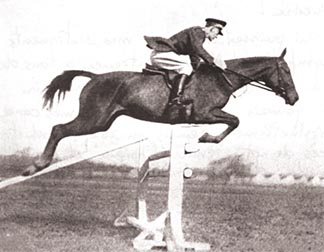
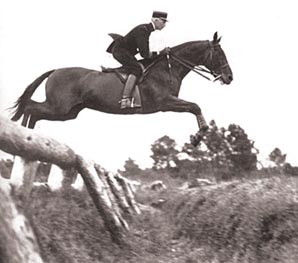
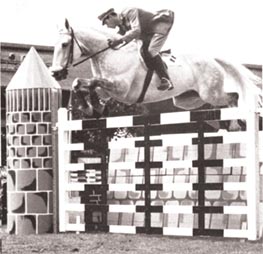
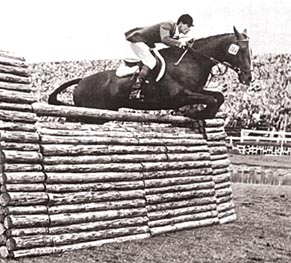
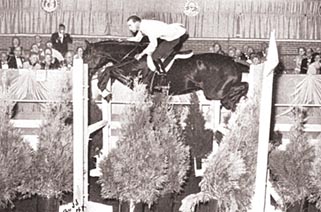
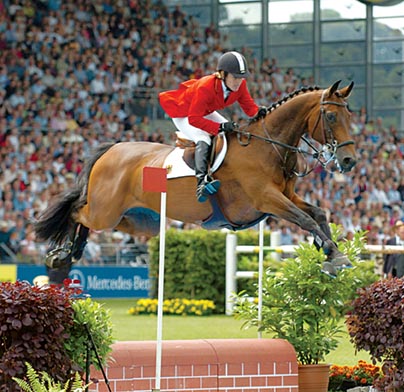
I am looking for details of an English/German(?) horse trainer,
particularly dressage called Windmahlen (or Windmalen). Can you help?
Henry wynmalen?